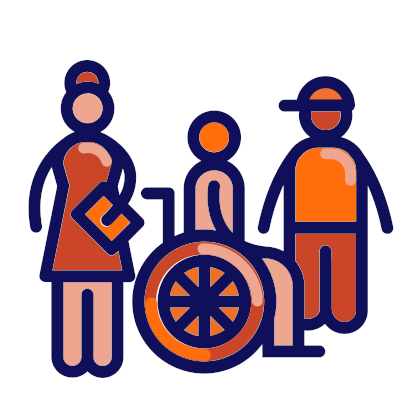Tackling discrimination

Schools can tackle discrimination by promoting democracy, respect for human rights and citizenship.
To ensure that all students’ needs are met equally, schools need to prioritise language and cultural competences, multiperspectivity in history and gender equality. In this way, students can acquire competences for democratic culture, to fulfil their potential in school as well as in society.
Facts & figures
Students with disabilities in Europe have higher early-school leaving-rates than their same-age peers.[1]
Black Caribbean students are three times more likely to be excluded from English schools than white pupils. [2]
A survey of nine EU countries showed that 33% of Roma students were in schools where most pupils were Roma, with 13% in Roma-only schools.[3]
What is discrimination?
Discrimination is treating a person badly or unfairly on account of a personal characteristic, such as national, ethnic or social origin, gender, language, religion, disability or sexual orientation.
There are two basic forms of discrimination:
- Direct discrimination – treating someone less favourably than you treat or would treat another person in the same situation, e.g., a school refusing to admit a student because they are Roma,
- Indirect discrimination – applying a provision, criterion or practice in the same way for all of a group which has the effect of unfairly disadvantaging people in the group who share a particular characteristic, e.g., a school uniform policy banning headgears for girls and boys may unfairly disadvantage Muslim girls and Jewish boys.
Discrimination can occur in almost any aspect of school life, from the attitudes and expectations of teachers to school rules and codes of conduct, selection and grouping practices, curricula, teaching methods and materials, changing facilities, career guidance, canteen food and the physical school environment.
Whatever form it takes – whether it be parallel school systems for different ethnic groups, concentrations of minority or disadvantaged children in the same school, or differential access to educational provision, it means a lower quality of educational experience for the students being discriminated against.
Why is tackling discrimination important at school?
Discrimination is a human rights violation. Article 14 of the European Convention on Human Rights contains a prohibition on discrimination with respect to any of the rights and freedoms guaranteed under the Convention. Article 2 of Protocol No.1 requires the state to ensure that all individuals have access to its formal educational provision.
“No person shall be denied the right to education.”[4]
“The enjoyment of the rights and freedoms set forth in this Convention shall be secured without discrimination on any ground such as sex, race, colour, language, religion, political or other opinion, national or social origin, association with a national minority, property, birth or other status.”[5]
Tackling discrimination is not simply a duty laid on schools by the European Convention of Human Rights, it is also important for student well-being and educational success. Children and young people who are treated unfairly or discriminated against are more likely to have:
- negative attitudes to school
- lower levels of motivation and academic achievement
- a higher risk of dropping out of formal education
- experience of bullying
- mental health problems.
Feeling different or ‘less’ than others can be an isolating experience. Over time it undermines an individual’s capacity for participation in society, e.g., their sense of self-efficacy, openness to other cultures and beliefs, tolerance of ambiguity and flexibility and adaptability - all of which lie at the heart of the Council of Europe Reference Framework of Competences for Democratic Culture.
Lack of opportunity due to discrimination in school also damages society. It intensifies social divisions, fuels xenophobia and intolerance and undermines social cohesion.
“States should adopt a combination of strong anti-discrimination measures and policies that promote more inclusive education systems where all children learn together. This is not a utopian project, but an achievable goal that can ensure more equal treatment of all children and, in the long term, improve social cohesion”[6]
What are the challenges?
One of the challenges facing the tackling of discrimination in schools is a lack of data. European-wide statistics specifically focused on discrimination in schools are scarce. Children with disabilities, for example, do not always appear in national statistics and may be ‘invisible’ to decision-makers, service providers and the public. Such children are particularly vulnerable to discrimination, however, and are often segregated in terms of educational provision.
These are not the only ‘invisible’ minorities in schools. For example, LGBTI students often feel they have to hide their sexual orientation at school to avoid victimisation.
Another key challenge is the existence of negative stereotypes about minority groups among teachers, parents, students and other school stakeholders. Such stereotypes are often deeply embedded in everyday school life and practice, so much so that they are taken as ‘normal’, e.g., stories and images in textbooks that reflect a stereotyped portrayal of the roles of women and men, girls and boys. Stereotypes help to fuel prejudiced and aggressive behaviour between students, lower expectations from teachers and negative attitudes from parents, e.g., refusing to allow their children to be taught alongside refugee or migrant children.
Stereotyping is difficult to root out in schools because its origins lie in wider society. This is exacerbated by the current preponderance of hate speech, fake news and conspiracy theories in digital media, especially social media.
The situation is compounded when minority groups are under-represented on school staff. Students lack role - models and teachers do not have the access to information about or insights into other cultures and ways of life that come with belonging to a more diverse profession. They lack the intercultural competences with which to create inclusive and quality learning environments, e.g., openness to cultural otherness, tolerance of ambiguity, plurilingual skills and knowledge and critical understanding of alternative cultures, religions and histories.
Tackling discrimination is more challenging when there is a lack of dialogue between schools and parents. Often this is on account of language difficulties, but it is also a problem where students’ parents work abroad leaving their children in the charge of elderly relatives or others.
How can schools get active?
Ensuring all learners of any age are provided with meaningful, high-quality educational opportunities alongside their peers requires a whole-school approach.
It begins by schools understanding who might be at risk of discrimination, what they can do to minimise discrimination and how they can support students at risk of discrimination. A good place to start is with an assessment of the current situation, identifying the strengths that exist in the school, but also needs and priorities. Consulting with school stakeholders is essential, especially students and, where possible, parents – e.g., using surveys, questionnaires, focus groups, etc. Given the sensitivities involved there is argument for collecting information on individuals’ experiences of discrimination anonymously.
Based on an assessment of the current situation it is possible to identify immediate priorities for policy development. Priorities will vary with the school, but might include, for example:
- language development
- gender equality
- accessibility of the physical environment
- intercultural competences.
The setting of initial priorities should go hand in hand with professional development for senior leadership teams as well as teaching staff. An element of personal as well as professional reflection is essential to the tackling of discrimination in school. In particular, it is important for school staff to be able to consider their own beliefs and values with regard to discrimination, including their own unconscious biases and prejudices.
Schools can then turn to the longer-term aspiration of creating a culture of non-discrimination. Central to this process is the challenging of negative stereotyping, both in classrooms and around the school. This can be done in a variety of ways, including:
- challenging stereotypes when they are heard
- discussing stereotypes with students
- identifying stereotypes in the curriculum
- highlighting stereotypical images and roles in textbooks
- allocating posts of responsibility equitably
- choosing different ways of dividing up students
- providing a range of role-models
- setting up mechanisms for monitoring incidents of discrimination.
Challenging stereotypes goes alongside the promotion of inclusion and an appreciation of the benefits of diversity in school life. This can take different forms, including:
- using inclusive language
- including human rights, democratic citizenship and intercultural education in the curriculum
- encouraging the discussion of controversial issues
- promoting student voice
- involving students in peer education and peer mediation activities
- welcoming parents and involving them in school decision-making
- forming partnerships with different organisations and groups in the community.
[1] Education section of the The European Disability Forum
[2] Article: UK: Racial discrimination is a reality in schools and classrooms. Education International
[3] EU Fundamental Rights Agency, “Second European Union Minorities and Discrimination Survey (EU-MIDIS II) Roma – Selected findings” (2017).
[4] ECHR, Article 2, Protocol No.1
[6] Position paper: Fighting school segregation in Europe through inclusive education by the Council of Europe Commissioner for Human Rights
 Resources on Tackling discrimination
Resources on Tackling discrimination
 Related schools projects
Related schools projects
Address:
Country: Cyprus
Project: Passengers on the Same Bus! No Discrimination, Segregation and Inequality!
 Working language during the project:
Working language during the project:
- English
 Themes of the Council of Europe campaign “FREE to SPEAK, SAFE to LEARN - Democratic Schools for All” covered:
Themes of the Council of Europe campaign “FREE to SPEAK, SAFE to LEARN - Democratic Schools for All” covered:
- Making children’s and students’ voices heard
- Preventing violence and bullying
- Tackling discrimination
- Improving well-being at school
 Competences from the Reference Framework of Competences for Democratic Culture (CDC) addressed and where / how they were integrated:
Competences from the Reference Framework of Competences for Democratic Culture (CDC) addressed and where / how they were integrated:
- Valuing Cultural Diversity
An introduction to the issues of Diversity through:
- 1. Workshop: “Race of Life” A role-play
- 3. Workshop: “My pot: different and unique”
- Activity C2: Diversity unites us, it does not separate us!
- Activity C3: Lets uproot bullying - Openness to Cultural otherness and to other beliefs, world views and practices
- Sociology course connected with games against discrimination
- A campaign against discrimination - Respect
Workshop: “We are all Unique”
Activity C4: “I am a refugee- a migrant - Not a Criminal.
 Target group age range:
Target group age range:
- 11-15
 Level of education:
Level of education:
- Lower secondary education
Short description of the project:
Our Project K229 Erasmus+ - Strategic Partnership for school is a 24-month project which began on 1st September 2018 and will end on 31st of August 2020. Our school is the coordinating school of the whole project. It is an ambitious project under the title “Passengers on the same Bus! No place for Discrimination, Segregation and Inequality”. Our project aims to make a bridge, initially connecting four European partners-schools in Cyprus, Finland, Italy and the Czech Republic and then integrating and sharing specific experience, viewpoints, knowledge and best practices on the issues of diversity, segregation, discrimination, inequality, bullying, and on migrant students in the school environment. Our project consists of four activities. Each country has undertaken one of the activities but we all work together to carry it out. The first activity is “Adopting and developing new communication technologies” and took place in Cyprus in November 2018. The participants were introduced to the issues of diversity, discrimination, inequality, segregation, bullying and the issue of migrant students through carefully designed experiential workshops, role-plays, drama, stories, artwork etc.
The second is due to take place in the Czech Republic in March 2019 under the title “Diversity Unites us, it does not separate us!” The third one will take place in Italy in October 2019 under the title “I am a refugee, a migrant - not a criminal”. The last one will take place in Finland in April 2020 under the title “Lets uproot bullying”. Each activity lasts for 5 days and a total of 38 participants from the four schools take part in each activity. Furthermore, all the activities have been carefully designed to meet the needs of the project and make its objectives achievable.
 Aims/objectives
Aims/objectives
- To secure the feeling of being valued by all our children and to fight discriminatory attitudes
- To promote social inclusion in our school environment
- To grow respect among pupils and an understanding of diversity
 Expected results/outcomes
Expected results/outcomes
- Knowledge and experience gained by pupils and staff as far as diversity, discrimination and segregation are concerned.
- Knowledge, awareness and experience gained by pupils and staff of the problem of bullying.
- Knowledge, awareness and experience of the inclusion of refugees in our school community.
- We expect pupils and staff, as well as participants to gain much knowledge and experience in thinking of ways to prevent and deter discrimination, inequality and diversity problems.
- Improve skills and knowledge concerning the use of new technologies to disseminate information about the work of our project.
 Changes
Changes
So far we have managed to raise awareness among a great number of students-participants from the four partner-countries on the issue of diversity. These students work as ambassadors for the acceptance of diversity, for fighting bullying, for accepting and respecting cultural, social, religious differences and for accepting the right of refugee students to share equal rights in their countries.
Our project consists of 4 activities. We have already carried out the first activity and we are moving on to the second. But we all four schools have observed that after the first activity in Cyprus:
- A great number of pupils have changed their attitude towards discrimination and segregation.
- They know about bullying and have a good sense of awareness.
- The number of cases of bullying has decreased in all four schools.
- With the first activity in Cyprus students have been persuaded in practice that although the students of the four schools have different culture, this cannot ever be a barrier to fostering cooperation and friendship.
- All the participants keep in touch with each other, via social network sites and they share ideas and in some cased have even developed friendship.
 Challenges you faced
Challenges you faced
Before the pupils from the three schools arrived, our students and parents were biased, although they didn’t want to accept this. There were a lot of worries about the differences of these pupils.
On the first day, our pupils expressed their surprise about the different way the hosting pupils behaved. On the third day they were singing and dancing Cypriot, Finnish, Czech and Italian songs and dances. On the last day, they were all crying, kissing and promising to keep in touch.
Another challenge was the communication, since not all participants spoke English. However, our activities placed emphasis on many feelings and fewer words. The workshops were well designed for achieving their goals, irrespective of the level of English. Examples: “The race of Life”, the story with the cracked pot, the clever quiz on the Kahoot , the poster with the pots, which all actually let the participant experience discrimination, segregation, inequality rather than learn definitions and rules.
 Time-frame of the project:
Time-frame of the project:
The whole project lasts 24 months. Each one of the 4 activities are 5 days long plus two days for travel.
 Council of Europe materials on citizenship and human rights education used while preparing or implementing your practice:
Council of Europe materials on citizenship and human rights education used while preparing or implementing your practice:
- Reference Framework of Competences for Democratic Culture
- All Different – All Equal
- Compasito
- We CAN!
- Human Rights and Democracy Start with Us – Charter for All
- Multimedia Material (ex. video “Beat Bullying”, series of cartoons “Democracy and Human Rights at School”, video “Corporal punishment at school: how two parents decided to change things”)







